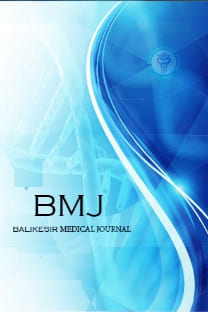Yeni Kurulan Bir Çocuk Nöroloji Polikliniğine Başvuran İlk 1000 Hastanın Retrospektif Değerlendirilmesi
A Retrospective Analysis of the First 1,000 Patients Being Admitted to A Newly Established Pediatric Neurology Outpatient Clinic
Child neurology, diagnosis, gender outpatient clinic, age,
___
- 1. Tan K, Patel S, Gandhi N, Chow F, Rumbaugh J, Nath A. Burden of neuroinfectious diseases on the neurology service in a tertiary care center. Neurology. 2008;71:1160-6.
- 2. WHO. Neurology atlas: country resources for neurological disorders. Report of program for neurological diseases and neuroscience. 2004
- 3. Ofovwe GE, Ibadin OM, Okunola OP, Ofoegbu B. Pattern of emergency neurologic morbidities in children. Journal of the national medical association. 2005;97(4):488-92.
- 4. Capildeo R, Haberman S, Rose FC. Neuroepidemiology in the developing countries. Journal of the Royal Society of Medicine. 1982;75:305-6.
- 5. Raina SK, Razdan S, Nanda R. Prevalence of neurological disorders in children less than 10 years of age in RS Pura town of Jammu and Kashmir. J Pediatr Neurosci. 2011;6:103–5.
- 6. Kliegman RM, Behrman RE, Jenson HB, Stanton BF. 18th ed. Chs 28, 29, 593, and 595. I and II. Philadelphia: WB Saunders; 2007. Nelson Text Book of Pediatrics; pp. 131–7. 2457, 2477-81.
- 7. Ogbe Z, Nyarang’o P, Mufunda P. Pattern of neurological diseases as seen in outpatient children: the experiences from Orotta Referral Hospital Asmara, Eritrea. Journal of Eritrean Medical Association. 2006;1;11-15.
- 8. Moges A, Gizae S, Zenebe G, Kotagal S. Pattern of Neurological Disorders at Pediatric Outpatient Neurologic Services at Tikur Anbessa Specialized Hospital. Ethiop J Pediatr Child Health. 2017;14:2.
- 9. Wammanda RD, Onalo R, Adama SJ. Pattern of neurological disorder presenting at a paediatric neurology clinic in Nigeria. Ann Afr Med. 2007;6:73-5.
- 10. Izuora GI, Anis AS. Neurological Disorders in Saudi Children at the Al-Majardah General Hospital, Asir Region. 1992;12(2):191-195.
- 11. Oduori ML, Shah SK. The pattern of neurological diseases in African children in Kenya. East Afr Med J. 1973;50:253-260.
- 12. Sykes RM. Epilepsy in children in Benin City, Nigeria. Ann Trop Paediatr. 2002;22:287-296.
- 13. Burton KJ, Allen S. A review of neurological disorders presenting at a paediatric neurology clinic and response to anticonvulsant. Ann Trop Paediatr. 2003;23:139-143.
- Yayın Aralığı: Yıllık
- Başlangıç: 2017
- Yayıncı: Balıkesir Üniversitesi
Alt Üriner Sistem ve Penis Travmaları Deneyimlerimiz
Murat DEMİR, Recep ERYILMAZ, Kerem TAKEN, Şeyhmuz ARAZ
Kolon Poliplerinin Ayırıcı Tanısında Yeni Bir Yaklaşım; Stereoloji
Ferah TUNCEL, Elif DEMİRCİ, Nesrin GÜRSAN
Nitrofurazona Bağlı Alerjik Kontakt Dermatit: 22 Olgudan Oluşan Bir Çalışma
Sjögren Sendromu olan Hastalarda Nötrofil/Lenfosit ve Trombosit/Lenfosit Oranlarının Araştırılması
Serap DURMUŞOĞLU ERBEN, Fatih KILIÇ, Mehmet ÜNSAL, Okan AYTEKİN, Günsu KİMYON CÖMERT, Alper KARALÖK, Osman TÜRKMEN, Ömer Lütfi TAPISIZ, Taner TURAN, Gökhan TULUNAY
Anıl TURHAN ÇAKIR, İsa Şükrü ÖZ, Burak ÜN
Covid-19 Şüphesi ile Başvuran Hastalarda Antikor Kimliği ve Diğer Parametreler
Özgür ÇELEBİ, Çiğdem Eda BALKAN BOZLAK, Sibel İBA YILMAZ, Demet ÇELEBİ
Tonsillektomi Vakalarında Malignite Oranı: Geriye Yönelik Analiz
